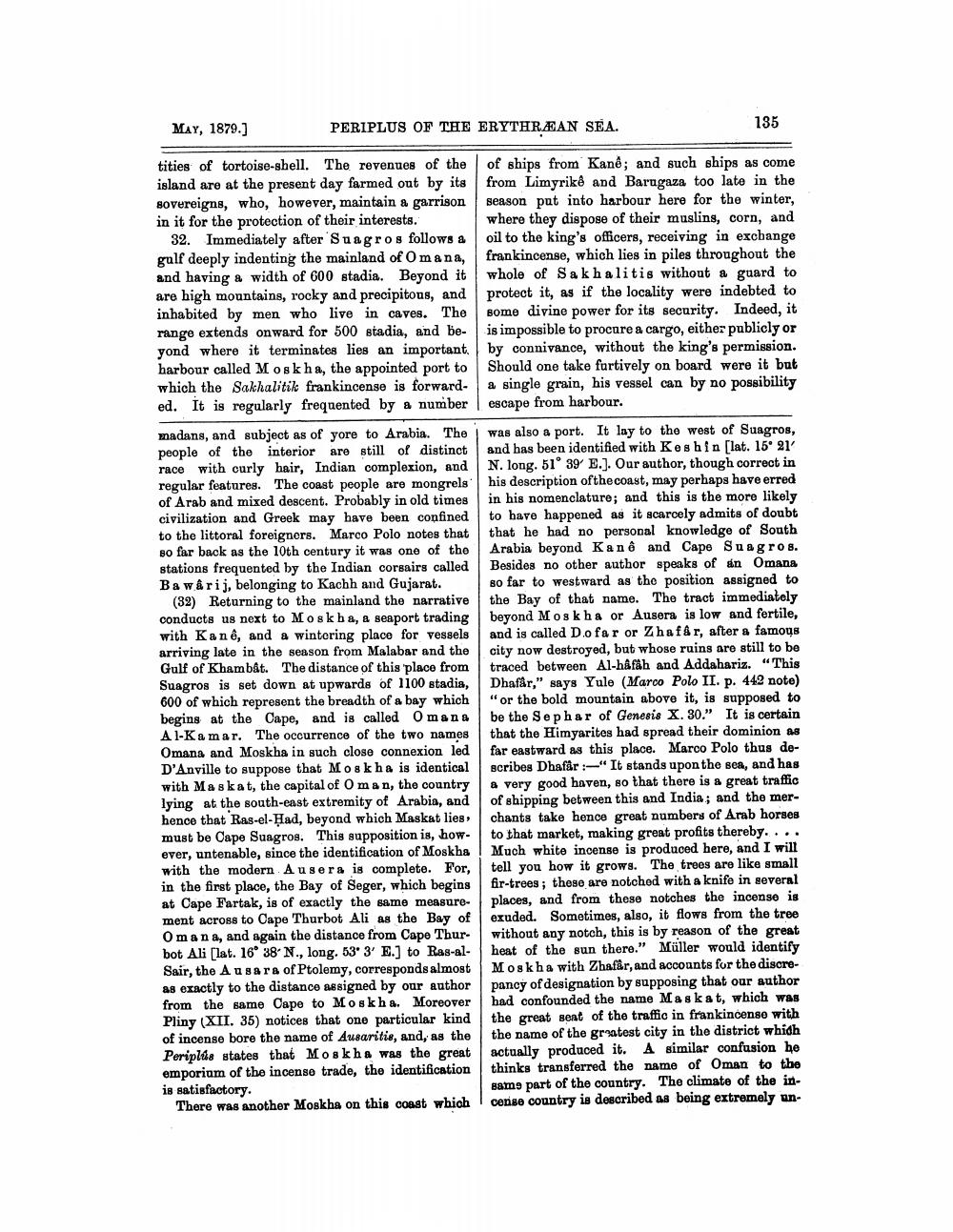________________
May, 1879.]
PERIPLUS OF THE ERYTHRÆAN SEA.
135
tities of tortoise-shell. The revenues of the of ships from Kanê; and such ships as come island are at the present day farmed out by its from Limyrikê and Barugaza too late in the sovereigns, who, however, maintain a garrison season put into harbour here for the winter, in it for the protection of their interests. where they dispose of their muslins, corn, and
32. Immediately after Suagros follows a oil to the king's officers, receiving in exchange gulf deeply indenting the mainland of Omana, frankincense, which lies in piles throughout the and having & width of 600 stadia. Beyond it whole of Sakhalitis without a guard to are high mountains, rocky and precipitous, and protect it, as if the locality were indebted to inhabited by men who live in caves. The some divine power for its security. Indeed, it range extends onward for 500 stadia, and be- is impossible to procure a cargo, either publicly or yond where it terminates lies an important by connivance, without the king's permission. harbour called Moskha, the appointed port to Should one take furtively on board were it but which the Sakhalitik frankincense is forward a single grain, his vessel can by no possibility ed. It is regularly frequented by a number escape from harbour. madans, and subject as of yore to Arabia. The was also a port. It lay to the west of Suagros, people of the interior are still of distinct and has been identified with Keshin [lat. 15° 21' race with curly hair, Indian complexion, and N. long. 51° 39' E.]. Our author, though correct in regular features. The coast people are mongrels his description of the coast, may perhaps have erred of Arab and mixed descent. Probably in old times in his nomenclature; and this is the more likely civilization and Greek may have been confined to have happened as it scarcely admits of doubt to the littoral foreigners. Marco Polo notes that that he had no personal knowledge of South Bo far back as the 10th century it was one of the Arabia beyond Kanê and Cape Suagros. stations frequented by the Indian corsairs called Besides no other author speaks of an Omana Bawârij, belonging to Kachh and Gujarat. so far to westward as the position assigned to
(32) Returning to the mainland the narrative the Bay of that name. The tract immediately conducts us next to Moskba, a seaport trading beyond Moskha or Ausera is low and fertile, with Kanê, and a wintering place for vessels and is called D.ofar or Zhafår, after a famous arriving late in the season from Malabar and the city now destroyed, but whose ruins are still to be Gulf of Khambat. The distance of this place from traced between Al-háfåh and Addahariz. "This Suagros is set down at upwards of 1100 stadia, Dhafår," says Yule (Marco Polo II. p. 442 note) 600 of which represent the breadth of a bay which "or the bold mountain above it, is supposed to begins at the Cape, and is called Omana be the Sephar of Genesis X. 30." It is certain Al-Kamar. The occurrence of the two names that the Himyarites had spread their dominion as Omana and Moskha in such close connexion led far eastward as this place. Marco Polo thus doD'Anville to suppose that Moskha is identical scribes Dhafår :-"It stands upon the sea, and has with Maskat, the capital of Oman, the country a very good haven, so that there is a great traffic lying at the south-east extremity of Arabia, and of shipping between this and India, and the merhence that Ras-el-Had, beyond which Maskat lies chants take hence great numbers of Arab horses must be Cape Suagros. This supposition is, how- to that market, making great profits thereby.... ever, untenable, since the identification of Moskha ! Much white incense is produced here, and I will with the modern Ausera is complete. For, tell you how it grows. The trees are like small in the first place, the Bay of Seger, which begins fir-trees; those are notched with a knife in several at Cape Fartak, is of exactly the same measure- places, and from these notches the incense is ment across to Cape Thurbot Ali as the Bay of exuded. Sometimes, also, it flows from the tree Omana, and again the distance from Cape Thur without any notch, this is by reason of the great bot Ali [lat. 16° 38' N., long. 53' 3' E.] to Ras-al- heat of the sun there." Müller would identify Sair, the Ausara of Ptolemy, corresponds almost Moskha with Zhafår, and accounts for the discreas exactly to the distance assigned by our author panoy of designation by supposing that our author from the same Cape to Moskha. Moreover had confounded the name Mask at, which was Pliny (XII. 35) notices that one particular kind the great sent of the traffic in frankincenso with of incense bore the name of Ausaritis, and, as the the name of the greatest city in the district which Periplus states that Moskhe was the great actually produced it. A similar confusion he emporium of the incense trade, the identification thinks transferred the name of Oman to the is satisfactory.
samo part of the country. The climate of the inThere was another Moskha on this const which cerise country is described as being extremely un




